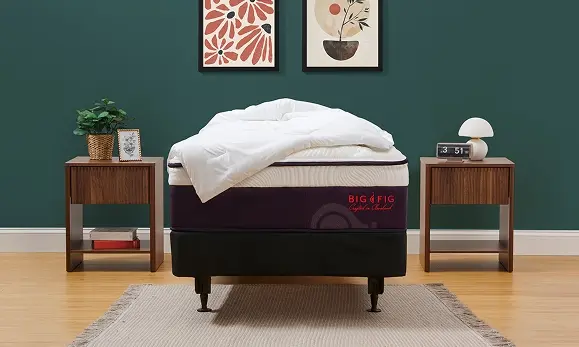Whether you’re a full-figured sleeper or not, the quality of your slumber is crucial for your mental and physical health. REM is one of the most vital sleep phases, which significantly influences your mood, immune system, and cognitive function. From problem-solving and decision-making to learning and memory, REM sleep plays a pivotal role.
But hey, let’s not get all gloom and doom. After all, sleeping should be a pleasure, right? However, to achieve quality sleep (even if you already have a Big Fig Mattress), you’ve got to understand the essential stages. While each phase has a purpose, let’s explore how to improve REM sleep so you can wake up bright-eyed, busy-tailed, and ready to face the day ahead.
The Stages of Sleep
When it comes to snoozing, it's not just about turning off the lights and diving into our Premium Cooling Sheets. A typical sleep cycle lasts around 90 to 120 minutes, and you can go through an average of four to five cycles per night! Let’s take a closer look at the fascinating stages of sleep, shall we?
Stage One
This phase represents the transition between wakefulness (put away those electronics, folks) and the initial beginnings of achieving a peaceful slumber. It’s short, fast, and typically only lasts a few minutes—yet it affects your heart rate, brain activity, breathing rhythm, and peepers, as eye movements slow slightly while your muscles relax. Sigh.
Stage Two
Also referred to as N2, stage two involves your body entering a more subdued state. Your heart rate, brain wave activity, and eye movement gradually slow, and muscles relax even further. However, despite short bursts of activity, you may still not completely wake up—and not just because of body pillow bliss!
Stage two lasts about 10 to 25 minutes during the first sleep cycle but can become longer as the night chugs on.
Stages Three and Four
Your heart rate, brain wave activity, and eye movement reach their lowest point during these restorative stages of sleep. Stages three and four are vital to our everyday health because it’s when your body heals itself.
What is REM Sleep?
Once you’ve finally left the restorative phase, your heart rate, blood pressure, and breathing increase, and your eyes rapidly shift from side to side, leading you to stage five, REM (rapid eye movement) sleep. Here, your brain wave activity intensifies, mimicking similar patterns as when you’re awake--which is possibly why most crazy dreams occur during this time (yeah, that recurring falling dream happens to us, too.) Even crazier, the brain activity that occurs during REM sleep is similar to what it's like when someone is awake. This stage typically lasts ten minutes and only accounts for twenty-five percent of your snooze.
Deep Sleep vs. REM Sleep
While deep sleep dominates the first half of your slumber, REM sleep eventually takes over and continues to get longer as you snooze. While the first REM stage may last only a few minutes, later stages can last upwards of an hour.
Why is REM Sleep Important?
REM sleep may not make up most of your sleep time, yet it significantly impacts your memory, mood, and learning. Research suggests that emotional experiences and memories are processed more easily during this short but sweet 90-110-minute snooze fest. It’s also the crucial phase where the brain rests, resets, and repairs itself so you can wake up refreshed, revived, and alert in the morning.
How Much REM Sleep Do You Need?
How many hours of REM sleep do you need? On average, adults need about seven to eight hours of sleep each night, and experts agree that REM sleep should make up about 20 to 25 percent of slumber to balance the other sleep stages.
How Much REM Sleep Is Too Much?
While there aren't standard guidelines for how much REM sleep is too much, some experts believe that getting more than 25% of your total snooze time in REM mode is a sign that you’re sleep-deprived because your body is making up for missed winks—this is known as the REM rebound effect. However, it's also normal for REM sleep to vary from person to person and even night to night, so don't stress if your REM sleep doesn't fit this exact pattern.
How to Increase REM Sleep
Since REM sleep occurs mainly during the second half of the sleep period, skimping out on sleep may require more time to complete all the REM sleep cycles. Here are a few tips to help you get sufficient quality sleep.
Maintain a Consistent Sleep Schedule
While it’s sometimes tempting to keep the tube on a bit longer or stay out late on the weekend, make an effort to go to bed and wake up at the same time each day. Doing so helps you set your body’s internal clock, known as the circadian rhythm. A consistent bedtime enables you to feel sleepy each night to get a sufficient amount of quality snooze time.
Create a Pleasant Sleeping Environment
If your bedroom is a mess, chances are you’ll never achieve quality sleep. Start by clearing out any clutter, whether an overpacked nightstand or piles of laundry on the floor. Other tips for creating a pleasant sleeping environment include:
- Invest in blackout shades to keep the room dark and cozy.
- Keep the room temperature at an ideal 60 to 65 degrees Fahrenheit.
- Regularly change your bedding so it’s always fresh and clean.
- Experiment with a white noise machine to see if it helps block out external noise, promote relaxation, and improve sleep quality.
- Use a sleep-enhancing aromatherapy pillow spray.
Establish a Bedtime Routine
Get yourself in the right mindset to get ready for bed with a nightly routine. For example, take a warm bath, make a cup of herbal tea, meditate, or read a few pages from a book (no electronics!) — whatever helps you wind down at the end of the day! Avoid alcohol, caffeine, or tobacco before hitting the sheets, as these stimulants can interfere with sleep stages.
Speak to Your Doctor
If you find it challenging to get ample shuteye, speak to your doctor. You may be taking a medication or have a disorder like sleep apnea that may be disrupting your REM sleep.
Get Better Sleep With a Big Fig Mattress
We understand that getting a good night’s sleep can sometimes be challenging — especially if you’re dealing with neck pain from sleeping wrong or back pain. Fuller-figured folks shouldn’t have to worry about sacrificing sleep quality, which is why we created Big Fig Mattresses. With features like heavy-duty foam that prevents sagging and THERMOGEL COOLING ® technology to help stop gross night sweats, you won’t have any problems getting enough REM sleep!
Enjoy a peaceful slumber each and every night with a when you find the Big Fig mattress best for you!







